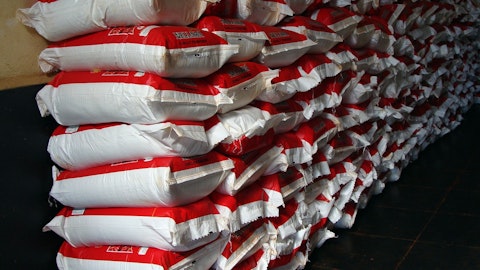Jeff Adelson: Okay. Great. Thanks for taking my question, Mat.
Mat Ishbia: Thank you.
Operator: Your next question comes from the line of Mark DeVries with Deutsche Bank. Please go ahead.
Mark DeVries: Yes. Thanks. Just had a follow-up question on the origination guidance for the first quarter. It’s a pretty wide range just given we are almost two-thirds of the way through the quarter. Can you just give us a better sense as to why that is? Kind of what scenario brings you to the low end of that range and what scenario brings you to the high end?
Mat Ishbia: Yes. Actually, I think I closed the range down. I usually give a $7 billion range. I think gave a $6 billion one. So, I actually gave a smaller range this time. But the truth is that trying to be consistent, $6 billion or $7 billion range. Obviously, I have a good feeling of where we are going to be, and that’s why I guided to that range. And I think we will be in the range like I am always in the range of my guidance from margins and volume perspective. And so you have got to realize that compared to last year’s first quarter and even the fourth quarter, I am basically guiding that we are going to do more business in a much higher rate environment in the tough mortgage industry. January, February, March are usually the slowest months.
Usually – actually November, December, January, February, the toughest months. Specifically January and February, especially when you are a purchase lender, when you are refi, it doesn’t matter when you are doing it. But your purchases, it’s slower in January and February. People aren’t moving while they are in school. It’s cold in the northern part of the country. There is a lot of reasons that purchases slowed down. So, I think 22 to 28 is a good guidance. I think 80 to 105 is a good guidance. And as I have done every single quarter, we always hit those guidances. And consistently, we will do that. I plan on doing that for the first quarter as well.
Mark DeVries: Okay. That’s helpful. Thanks.
Operator: [Operator Instructions] Your next question will come from the line of Eric Hagen with BTIG. Please go ahead.
Eric Hagen: Hi. Thanks. Good morning. I hope you guys are well. A couple of more follow-ups on the MSR, I mean are you still targeting an MSR portfolio around, call it, $300 billion of UPB? And can you also remind us does your MSR fair value mark include an estimate for recapture? Thank you.
Mat Ishbia: Yes. So, good question. Obviously, in the weeds, you know the game. No, we do not put an estimate for recapture in there. So, therefore, that’s what all of my other competitors do to beef up their numbers, which is a false way of doing it, but you get that and understand the business well enough to ask the question. So, you know that. On the other side of it, MSR is $300 billion, like we look at it what’s the right range. There is not an exact range. But I think it’s important if you got an MSR book that you can originate, I think at least half of your origination book, if not a little bit more. So, I think like we look at, can we do more than $150 billion, yes, we can. So, I wouldn’t want to go much higher than $350 billion or $400 billion on the book, but I probably won’t go below $200 billion in that.
So, I think $250 billion to $350 billion is the right range. That’s kind of where we will see it. We are doing a lot of business right now. We will sell some here and there. But $250 billion to $350 billion is the right range. If you want me to tighten up, I would probably say $275 billion to $325 billion, but I think du are saying $300 billion, so plus or minus, that’s right.
Eric Hagen: Love it. Great. Thank you. Thank you very much for that. We know that there is a lot of competition between broker and retail, a lot of migration, loans going back and forth between the channels sometimes. But how aggressive or how much market share do you feel like you could take out of the correspondent channel this year?
Mat Ishbia: Well, so honestly, the correspondent channel is not really a channel. I know some of our competitors like to say that they originate loans in the correspondent channel. But if you don’t underwrite the loan or don’t originate the loan, you didn’t the loan, right. You can’t do the loan twice. And so I don’t really look at any volume in the correspondent channel. I know some places report correspondent volume. But honestly, there is retail, and there is wholesale. That’s all the originations because correspondent is some retail lenders do the loan and then they sell it to a Chase or a Wells. And then Wells and Chase report that as their volume. And then so does the retail guys, so it’s really double counting.
So, I really don’t look at correspondent as an opportunity to grow the business. I look at it, it’s actually just people reporting numbers incorrectly. But on the flip side, there is lot of banks that are getting out of the market because of different capital rules, different things, but also in pure lines, like to play the capital rules and the banks will tell you, oh, the capitals are harder to originate mortgage, mortgage doesn’t make sense. But the truth is, it’s really hard to compete. Like all we do is mortgage. We live, eat, sleep mortgage. And banks and other places do a lot of business, a lot of different things. And by the way, they are great partners and a lot of do – a lot of great things for all of America, but it’s hard to be great at 28 things.




